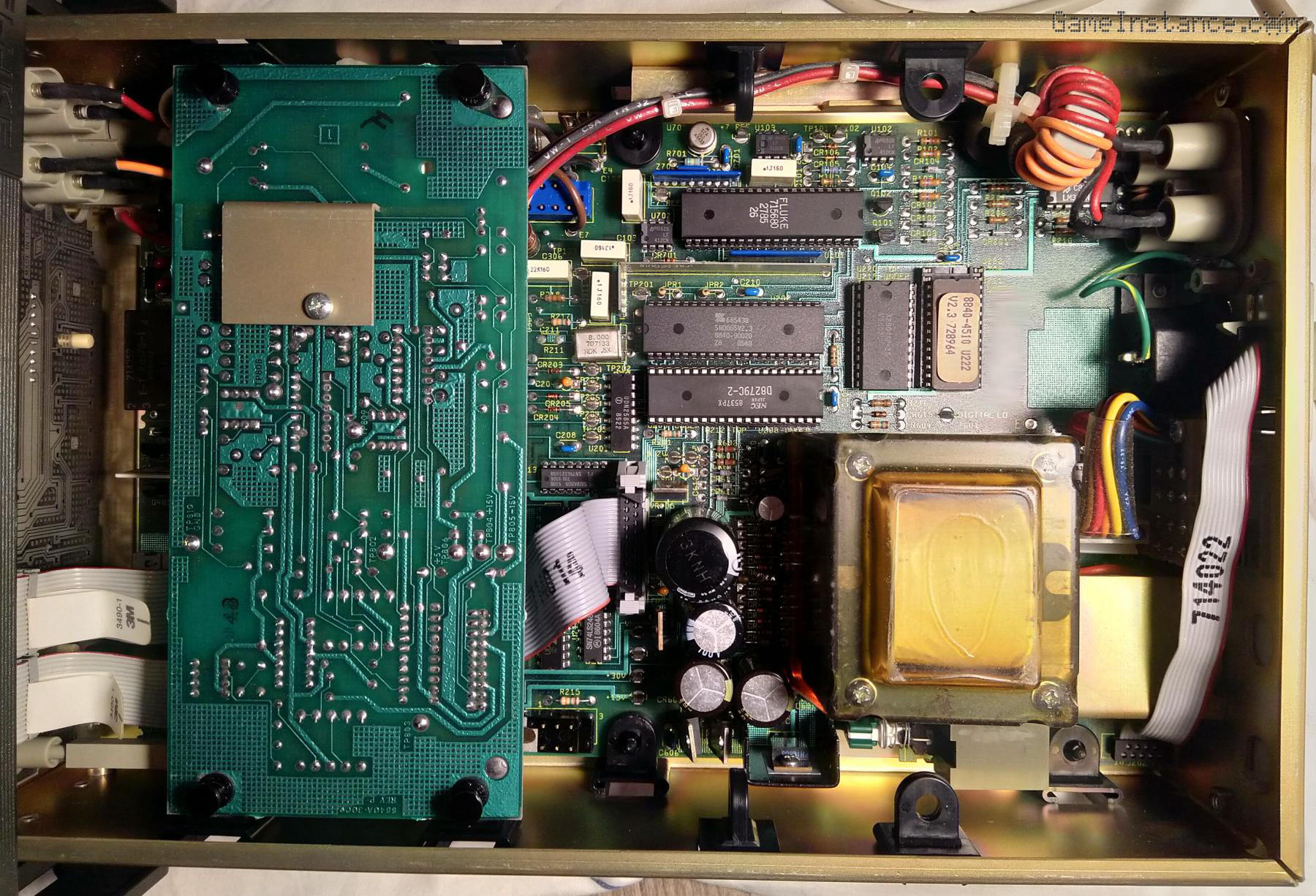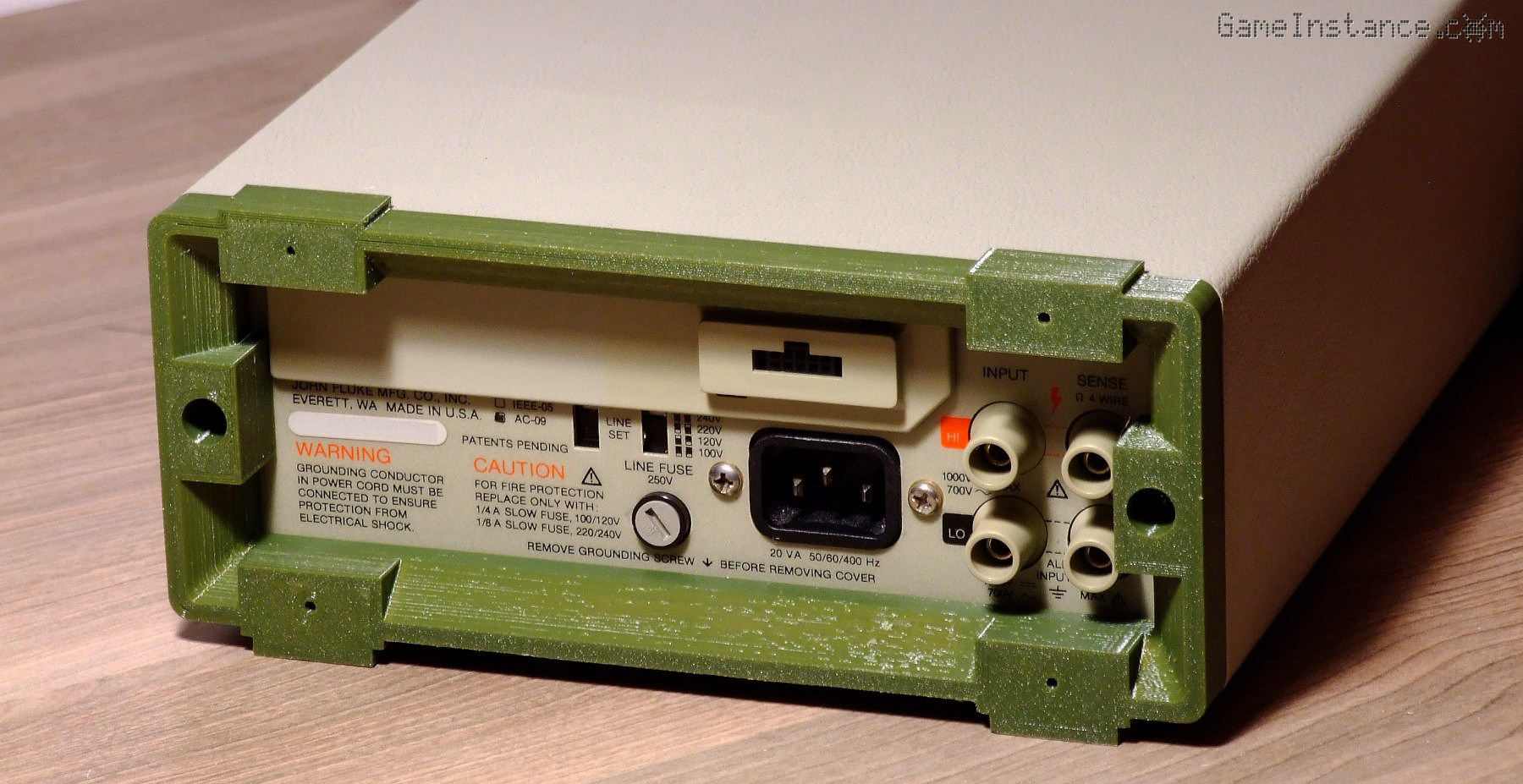Built on a decade old design, Fluke 8840A was the precision DMM in the early 90s and remains a highly appreciated tool in today's terms. It relies on a precision voltage reference, accurate analog ICs and a handful of proprietary Fluke ASICs. The digital circuitry revolves around a Zilog 8bit in-guard MCU, along with its RAM and ROM chips. It has dedicated logic chips and a completely independent Intel display and keyboard interface. All these on a pure 80s multi-layer THT board. My new-old Fluke, because I had to have one, has the True RMS AC option-O9 but lacks the IEEE488 option-O5.

Did I say I'm a VFD passionada? Yes, this unit has a vacuum fluorescent display with five large and bright 7-segment groups, commas and various labels. They were preferred in the early 80s (and later) for their functional limitation of needing the offset voltage both on the gate and the anode in order to be activated. This feature made them simpler to multiplex and that meant a cost reduction for the driving circuitry. I like them because they inherit some characteristics of the old CRT technology at much safer voltages.
I bought it as a bargain, with a defective display. I always wanted to debug one of these VFD, betting on the fact it might still be functional. It turned out the problem was elsewhere, very common and the fix was very simple. With a cap replacement and a nice cleanup, I got myself yet another cool device which, mind you, is in reasonable shape.
On arrival
The unit had some dirt on it, which is normal after a good 30 years of lab/shop use. It has a sticker with the latest calibration, dating from Nov 1995. It came with some case deformation, consistent with shocks or being pressed in between two semi-hard pieces. One could see the transformer shape protruding the top and a screw shape on the bottom of the aluminum case. This poor old Fluke has seen a fair share of packing and moving/shipping. The rear panel bezel was gone, missing that is, and the only thing left of it was a piece of plastic held by the one remaining bezel screw.

A bit concerned about the integrity of the contents, especially since there was something dangling inside, I slid the case out the back to look inside. Besides a smidge of dust, the internals were fine and the loose object was another broken piece of the plastic bezel.
Design
The 8840A, like most DMM of its kind, has two input ports one of which is located at the back. The input selection is made via a chunky multi-pin switch. The cables from each input are wound around high-frequency noise suppressing cores and are landing on the main board. According to the selection: VDC, VAC, IDC, IAC the signal follows various scaling circuits, ending onto the sample&hold and the ADC. For the Ohms selection, an additional current source is internally employed to generate the voltage drop and for improved precision, like other similar devices, it can feed the current on one port and probe the voltage drop on another, AKA 4-wire Ohm meter. It doesn't have features like frequency meter, temperature meter, diode drop, or continuity beeper.

Internally, it is very neat and tidy. I love the potted transformer, the DIP sockets on all major digital chips, the overall joyful colors of all parts, the fact that supply regulators are positioned centrally, near the transformer, with power lines branching towards each sub-module. Although the PCB is multi-layer, there's no ground/power planes on the inner layers. The optional boards are disposed few inches above the main board and are affixed with plastic self-tapping bolts.
Display problem
First to be checked were the power rails. Each had the voltage and ripple within specs, even though the capacitor on the unregulated side of the +5VDC was visibly bulged-out. However, as I was tapping various test points with my scope's probe, the display suddenly came back to life, momentarily, and then slowly faded off. This unit uses a +30VDC offset for the display gates and anodes, which was present, but the cathode filament 4.5VAC was iffy. With all filaments obviously intact, I traced the problem back to the transformer which had a cold joint on one of the secondary's pins. This was the effect of an imperfect design combined with improper handling. The transformer is affixed onto the board with screws in only 3 corners making the secondary terminals at the loose extremity prone to mechanical stress. Subjected to pressure and shocks during transport, the filament secondary terminals located in the unfortunate corner got pushed/pulled off the pad.

Re-soldering the three affected terminals - three because the AC secondary is center tapped and offset to +5VDC - solved the problem. This unit doesn't seem to have been used all that much, judging by the integrity of the phosphorus anodes and thus the brightness of the display segments.
Recapping
The capacitor on the unregulated side of the +5VDC rail - a 6800uF 16V Nichicon - was bulged, denoting pressure buildup, which is a sign of failure for a number of reasons including electrolyte aging, mechanical stress or overheating - all applicable to this unit.

I had that changed with another Nichicon having the same specs and form but with a higher maximum voltage, as they can better handle ripple. Since one cannot always know the actual age of a new capacitor, it is recommended to perform a reforming procedure by feeding it a 1mA current up to the maximum rated voltage, holding it for approximately one hour and then slowly discharging it. This helps eliminate any leakage current it may develop after being stored for longer periods.
3D printed rear bezel
There's a huge community of people contributing to such emblematic DMMs. Some made LED display assembly replacement kits and another went the extra mile to design and build the True RMS option-09. I was interested only in the missing rear bezel STL model.
